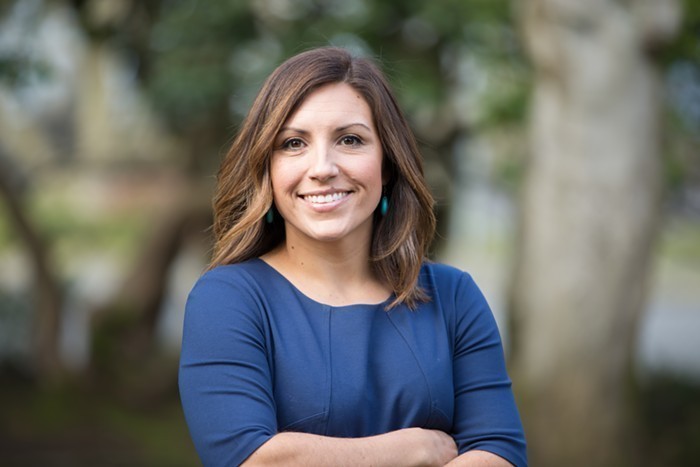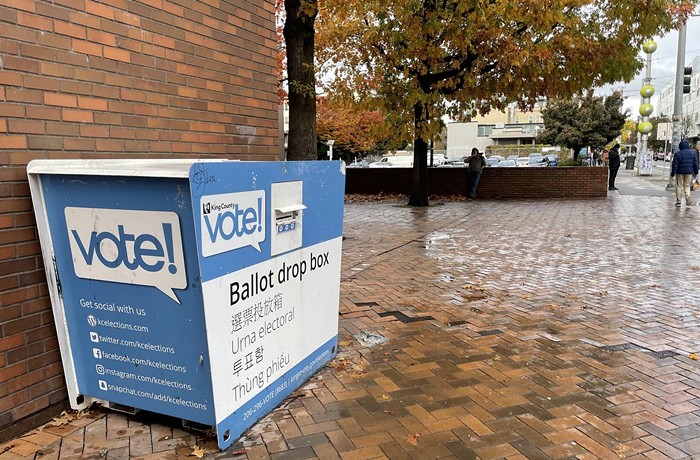
A massive portrait of Sananda Maitreya has overlooked students in a hallway inside Mary Gates Hall on the University of Washington’s Seattle campus since the summer. Maitreya, a 1980s pop star formerly known as Terence Trent D’Arby, is depicted on a seven-by-eight-foot canvas, with a stone-faced expression. He forces passersby to confront him and his Blackness, said the artist, UW alumnus Miha Sarani.
But that confrontation irked someone enough that, just after Thanksgiving weekend, an unknown assailant slashed through Maitreya’s unsmiling painted mouth. A representative from the University of Washington Police said their department is still investigating the incident.
“It’s cut quite symbolically,” said Sarani. “There have been a lot of people who have reached out to me since the vandalism and often, it was people of color. It felt like it was a personal attack on them also.”
For Sarani, a Slovenian immigrant who first came to the United States in 2002, the hate behind the attack on his painting feels particularly personal.
“I grew up when there was a war in Balkans,” he said. “I was just a kid, but I was attacked by skinheads. It was a hard beating I took that landed me in intensive care for three weeks. The psychological damage left its residue on me.”
Sarani painted Maitreya, one of his childhood heroes, as part of a series for his UW Arts Bachelor in Fine Arts thesis last year. In creating the series, which included portraits of two musicians of color—Maitreya and singer and songwriter Barrett Strong—Sarani confronted how race has been documented in art throughout history.
“There’s a whole history of early American painting in which [Black people] would be shown often with a submissive smile,” he explained. “A smile wasn’t a smile of joy. They weren’t smiling because they were having a good time. They were shown as entertainers, not as a person. They were seen as an object.”
Framing the incident in the context of the upcoming inauguration of a candidate who spent the past year campaigning on racism and xenophobia, helps Sarani make sense of the vandalism.
“To me, with a lot of events and incidents [of hate] that have been happening post-election, it’s a scary reminder that things haven’t been resolved for the better,” said Sarani. “Since the paintings were done—and I know they weren’t done in a utopia la la land—it seems like things [have gotten worse].”
A report from the Southern Poverty Law Center found that in the 10 days following Trump’s election, 867 hate incidents were reported nationwide.
Since his painting was defaced, Sarani said he’s received an outpouring of support from friends and the university and arts communities. Many of the people who reached out were “people of color [who] felt like it was a personal attack on them also,” he said.
Ed Taylor, dean of UW’s Undergraduate Academic Affairs department, could not be reached for comment. A representative from UAA said that the vandalism is “a terrible, terrible incident and we’re upset by it. The painting is a wonderful, compelling work of art.”
Sarani first saw the act of vandalism as a devastating blow, but he’s since changed his perspective. The slash through Maitreya’s mouth just made the painting’s message of empowering people of color “a lot louder than it [was] before,” the artist said.
The painting was removed from Mary Gates Hall after it was vandalized, but it will go back on display once the canvas—wounds and all—is reinforced, he said.
Moving forward, Sarani plans to combat the fraught history of painting people of color through future works. Focusing his painting on marginalized peoples feels especially important as President-elect Donald Trump prepares to take office after a year of racist and xenophobic campaigning, he said.
“It made me rethink the direction I want to take my art and how art should be a commentary on the things happening around you – not trendy, not a knee-jerk reaction, but what’s happening in time.”


















